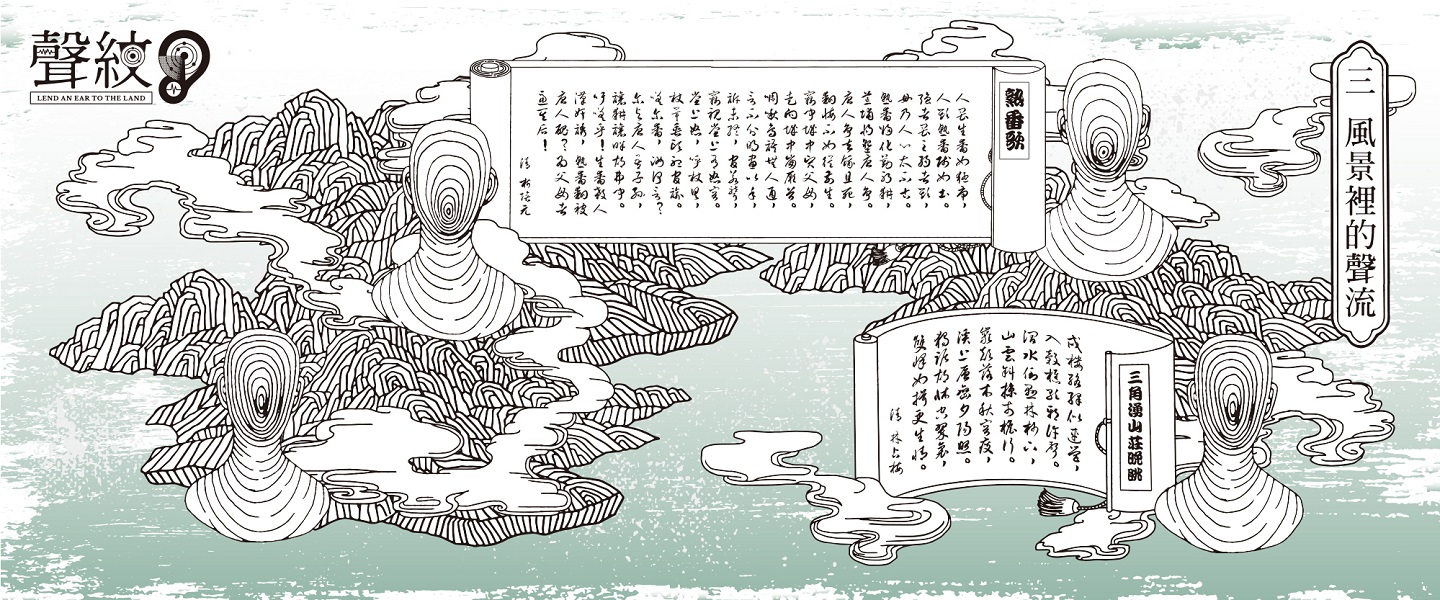Listen♫
Intro
- Sound, 2022
Atelier Hui-Kan, Yenting Hsu

Flowing Sounds in a Landscape
Sanxia is located at confluence of the Dahan, Sanxia, and Heng Rivers. Its former name, Sanjiaoyong, was a reference to this abundance of water, as well as the topography of the area which slightly resembles a triangle. The area’s earliest inhabitants were the Pingpu Indigenous peoples (Kulon of the Ketagalan). In 1685, immigrants from China arrived in Hai Shan (which today encompasses Shulin, Sanxia, and Yingge) to settle the land. In 1713, following Chen Heyi’s request that the government begin developing the land around Hai Shan, the area was gradually sinofied and local indigenous groups assimilated into the Han culture of the settlers. Historical records show that by the reign of emperors Tongzhi and Guangxu most Indigenous peoples had disappeared from the area.
According to legend, one of the earliest Han settlers in Sanxia was Dong Rixu who hailed from Anxi County in Quanzhou Prefecture. In 1755, he was said to have begun development of huge tracks of land stretching from Yingge to Sanxia. Sanxia’s oldest Zushi Temple and the Xinglong Temple were also constructed during this period. Similar to other areas of northern Taiwan, the relationship between Indigenous peoples and Han settlers was that of cycles of rise and fall, of intermixing, of partial integration, and the cultural repression by more dominant ethnic groups.
This is a sound journey across time and space, one starting from the second half of the 19th century. The poet Lin Chan-Mei, who came from Hsinchu and whose ancestors hailed from Fujian’s Tongan, was traveling through Sanjiaoyong when he left behind a poem describing the unique scenery of the area: one of mountain and river scenery and nearby human habitation.
Oral Accounts:
Huang Han-Kun. “Looking at Sanjiaoyong in the Distance.” Narrated in Taiwanese
Huang Chun-Chi. “Song of the Assimilated Barbarian.” Narrated in Taiwanese, Anxi Dialect
Pan Liang Fen Ying
References:
Lin Chan-Mei. “Looking at Sanjiaoyong in the Distance.” 1864.
Ke Pei-Yuan. “Song of the Assimilated Barbarian.” 1834.
Historical Recordings:
- Nan Guan. “Precipitous Mountain.” Performed by Xiamen-based geisha Tsai Hsia. Sounds of Taiwanese History: 1910-1945. Reproduction of Taiwanese Operatic Recordings. National Center for Traditional Arts.
- Dirge. (Ketagalan Basai Dialect) 1936. Sung by Pan Shiyao, High Ranking Female of the Sandiego Tribe. Collected Ping-pu Memories: On Representing Kavalan and Ketagalan Voices and Images. National Taiwan University Press.
- Hakka Beiguan. “New Year’s Spirit/Welcoming in the New Year,” 1914. Nipponophone Co. Ltd.
- Ketagalan-Basay People (offering song, Danshui communities)」。Singer : Pan Liang Fen Ying.
- Beiguan music - Hakka Bayin, first commercial publication, 1914, Nipponophone Co. Ltd.
Ceremonial Recordings:
- Sanxia Zushi Temple’s “Welcoming the Gods of Loyalty”
Special Thanks to Chen Jia-Chi, Cheng Ying -Zhen, Tseng Yun-Chieh, Chen Cheng-Tao
